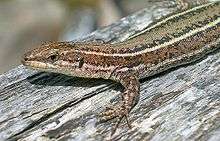Podarcis hispanica
| Podarcis hispanica | |
|---|---|
 | |
| Scientific classification | |
| Kingdom: | Animalia |
| Phylum: | Chordata |
| Class: | Reptilia |
| Order: | Squamata |
| Family: | Lacertidae |
| Genus: | Podarcis |
| Species: | P. hispanica |
| Binomial name | |
| Podarcis hispanica Steindachner, 1870 | |
 | |
| P. bocagei = dark green P. vaucheri = mid green P. muralis = pale green P. carbonelli = reddish-brown P. hispanica = other colours | |
Podarcis hispanica (Iberian wall lizard) is a small wall lizard species of the genus Podarcis. It is found in the Iberian peninsula, in northwestern Africa and in coastal districts in Languedoc-Roussillon in France. In Spanish, this lizard is commonly called lagartija Ibérica.[1]
Description
The Iberian wall lizard varies considerably in size and colouring across its range. It is a fairly small, slender, somewhat flattened species with a snout-to-vent length (SVL) averaging 50–70 mm (2.0–2.8 in) and a tail twice as long as its body. The background colour is usually grey or brown but is occasionally greenish. Most individuals have three narrow longitudinal stripes, one along the spine and the other two more distinct and on either side. Sometimes these are broken up into a series of streaks or marks. Some males instead have a reticulated (netlike) pattern and others are more uniform in colour. The throat is pale with a scattering of small spots, particularly near the sides, and the belly is usually whitish but may be pink, orange, red or buff. Young lizards may have blue tails.[2]
Distribution and habitat
The Iberian wall lizard forms part of a species complex of Podarcis wall lizards occurring in the Iberian Peninsula and the Maghreb region of North Africa. The range map shows the boundaries between the species and includes P. bocagei, P. vaucheri, P. muralis, P. carbonelli and several different subspecies of P. hispanica.[3]
Several different subspecies of the Iberian wall lizard are found in Spain and Portugal (where it is the only small lizard over most of the southern half of Iberia), southwestern France, Morocco, Algeria and Tunisia. A subspecies of this lizard, Podarcis hispanica atrata, lives in the Columbretes Islands far off the eastern coast of the Iberian Peninsula.[1]
Studies of mitochondrial DNA have shown that there is some gene flow between these species and that they hybridise to some extent where their ranges meet.[3]
It is a climbing lizard and is found on rocks, cliffs, walls, parapets, road cuttings and occasionally tree trunks at altitudes of up to 2,500 m (8,200 ft).[2]
Biology
The Iberian wall lizard is very agile and can move rapidly across a rock face. Males are somewhat territorial. Females lay clutches of one to five oval eggs which hatch in about eight weeks. At birth, the juveniles have a snout-to-vent length of 2 to 2.5 cm (0.8 to 1.0 in). The lifespan of this lizard is about four years.[2]
Status
The Iberian wall lizard has a wide range and is common over much of that range. It is assumed to have a large total population, it is able to adapt to modifications of its habitat and it faces no particular threats, so the International Union for Conservation of Nature has assessed its conservation status as being of "least concern".[1]
References
 Media related to Podarcis hispanica at Wikimedia Commons
Media related to Podarcis hispanica at Wikimedia Commons
- 1 2 3 4 Jose Antonio Mateo Miras; Marc Cheylan; M. Saïd Nouira; Ulrich Joger; Paulo Sá-Sousa; Valentin Pérez-Mellado; Iñigo Martínez-Solano (2009). "Podarcis hispanica". IUCN Red List of Threatened Species. Version 2014.2. International Union for Conservation of Nature. Retrieved 2014-10-24.
- 1 2 3 Arnold, E. Nicholas; Ovenden, Denys W. (2002). Field Guide: Reptiles & Amphibians of Britain & Europe. Collins & Co. pp. 151–152. ISBN 9780002199643.
- 1 2 Catarina Pinho; D. James Harris; Nuno Ferrand (2008). "Non-equilibrium estimates of gene flow inferred from nuclear genealogies suggest that Iberian and North African wall lizards (Podarcis spp.) are an assemblage of incipient species". BMC Evolutionary Biology. 8 (63). PMC 2277379
 . PMID 18302778. doi:10.1186/1471-2148-8-63.
. PMID 18302778. doi:10.1186/1471-2148-8-63.
